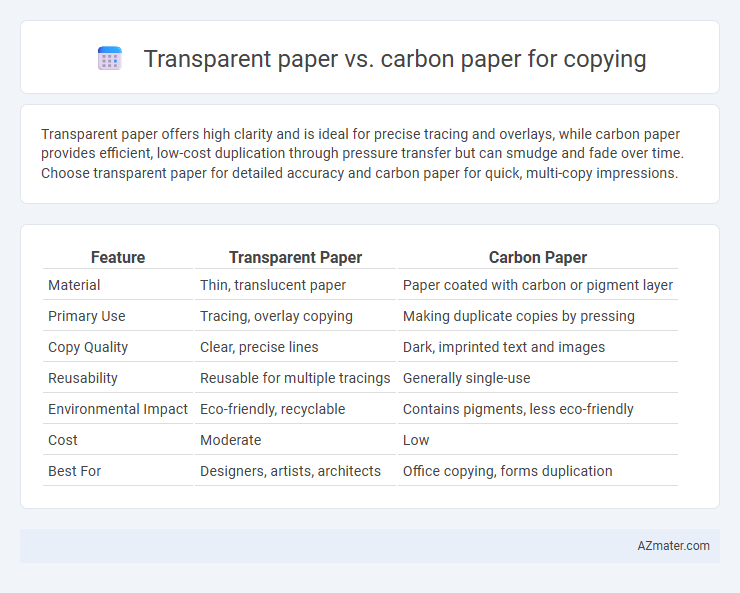Transparent paper offers high clarity and is ideal for precise tracing and overlays, while carbon paper provides efficient, low-cost duplication through pressure transfer but can smudge and fade over time. Choose transparent paper for detailed accuracy and carbon paper for quick, multi-copy impressions.
Table of Comparison
| Feature | Transparent Paper | Carbon Paper |
|---|---|---|
| Material | Thin, translucent paper | Paper coated with carbon or pigment layer |
| Primary Use | Tracing, overlay copying | Making duplicate copies by pressing |
| Copy Quality | Clear, precise lines | Dark, imprinted text and images |
| Reusability | Reusable for multiple tracings | Generally single-use |
| Environmental Impact | Eco-friendly, recyclable | Contains pigments, less eco-friendly |
| Cost | Moderate | Low |
| Best For | Designers, artists, architects | Office copying, forms duplication |
Introduction to Copying Techniques: Transparent Paper vs Carbon Paper
Transparent paper provides a modern copying technique by allowing light to pass through, enabling precise tracing and easy duplication of designs or text. Carbon paper, a traditional medium, transfers ink from one sheet to another through pressure, making it ideal for creating multiple copies simultaneously. Compared for efficiency, transparent paper is favored for accuracy and detailed reproductions, while carbon paper excels in speed and simplicity for multi-copy tasks.
What is Transparent Paper?
Transparent paper, also known as tracing paper, is a thin, translucent material used primarily for copying and tracing images or designs with precision. Made from cellulose or synthetic fibers, it allows light to pass through, enabling users to see underlying documents clearly for accurate replication. Unlike carbon paper, transparent paper does not deposit ink but serves as a medium for manual tracing or sketching.
What is Carbon Paper?
Carbon paper is a thin sheet coated with a layer of carbon or similar pigment used for making duplicate copies by placing it between two sheets of paper; pressure from writing or typing transfers the pigment onto the bottom sheet. Unlike transparent paper, which allows light to pass through for tracing images or drawings, carbon paper creates copies through direct contact and pressure, making it ideal for handwritten duplicates. This method is widely used in forms, receipts, and invoice generation where instant copies are necessary without electronic devices.
Key Differences Between Transparent Paper and Carbon Paper
Transparent paper offers clear visibility and is ideal for tracing and light copying tasks, using ink or pencil without leaving residue. Carbon paper contains a thin layer of pigmented coating that transfers ink onto the underlying sheet through pressure, making it suitable for making multiple copies simultaneously. Unlike carbon paper, transparent paper is reusable and does not produce smudges or mess during the copying process.
Advantages of Using Transparent Paper for Copying
Transparent paper offers superior clarity and precision for copying compared to carbon paper, ensuring detailed and accurate replicas of original documents. It reduces smudging and ink transfer issues commonly associated with carbon paper, resulting in cleaner copies. Additionally, transparent paper is reusable and environmentally friendly, minimizing waste and costs in repeated copying tasks.
Benefits of Carbon Paper in Copying Processes
Carbon paper provides sharp, clear duplicate copies instantly, making it ideal for multi-part forms and receipts. It enhances efficiency by producing carbon copies without the need for additional electronic devices or printers. The cost-effective nature of carbon paper supports high-volume copying with consistent quality and minimal waste.
Limitations and Drawbacks of Each Copying Method
Transparent paper offers limited durability and can smudge easily, reducing the clarity of copied images over time. Carbon paper often results in inconsistent ink transfer, leading to uneven or incomplete copies and may cause smudging on original documents. Both methods lack the precision and permanence found in modern digital copying technologies, affecting their effectiveness for high-quality reproductions.
Best Use Cases for Transparent Paper and Carbon Paper
Transparent paper excels in tracing, drafting, and artistic projects due to its clarity and smooth surface, ideal for transferring precise designs and overlays. Carbon paper is best used for making multiple carbon copies simultaneously in writing or form duplication, providing efficient and cost-effective reproduction of handwritten or typed documents. Selecting transparent paper suits tasks requiring high precision and clarity, while carbon paper is preferred for quick, multiple-copy generation in administrative settings.
Environmental Impact: Transparent Paper vs Carbon Paper
Transparent paper, often made from cellulose or synthetic fibers, tends to have a lower environmental impact compared to traditional carbon paper, which contains toxic chemicals and heavy metals that can harm ecosystems during disposal. Transparent paper is more easily recyclable and biodegradable, reducing landfill waste and pollution, whereas carbon paper's ink residue and non-biodegradable backing contribute to soil and water contamination. Choosing transparent paper supports eco-friendly office practices by minimizing harmful chemical use and promoting sustainable material cycles.
Choosing the Right Copying Paper: Factors to Consider
Choosing the right copying paper depends on the specific needs of the project and the desired quality of the copy. Transparent paper offers high precision and is ideal for tracing and design work due to its clear surface and smooth texture, while carbon paper provides a cost-effective solution for creating multiple copies quickly by transferring ink from one sheet to another. Factors such as the number of copies required, durability, desired clarity, and compatibility with the copying equipment play crucial roles in selecting between transparent paper and carbon paper.

Infographic: Transparent paper vs Carbon paper for Copying
 azmater.com
azmater.com